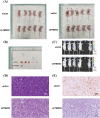TMED3 promotes prostate cancer via FOXO1a and FOXO3a phosphorylation
- PMID: 39735675
- PMCID: PMC11671412
- DOI: 10.32604/or.2024.048054
TMED3 promotes prostate cancer via FOXO1a and FOXO3a phosphorylation
Abstract
Background: Transmembrane emp24 trafficking protein 3 (TMED3) is associated with the development of several tumors; however, whether TMED3 regulates the progression of prostate cancer remains unclear.
Materials and methods: Short hairpin RNA was performed to repress TMED3 in prostate cancer cells (DU145 cells) and in a prostate cancer mice model to determine its function in prostate cancer in vitro and in vivo.
Results: In the present study, we found that TMED3 was highly expressed in prostate cancer cells. In vitro, shTMED3 treatment suppressed the proliferation, invasion, and migration and promoted the apoptosis of DU145 cells. Additionally, the Kyoto Encyclopedia of Genes and Genomes pathway enrichment analysis showed a strong correlation between TMED3 and forkhead box O transcription factor (FOXO) pathway. Furthermore, TMED3 inhibition efficiently decreased FOXO1a and FOXO3a phosphorylation. In vivo, TMED3 downregulation suppressed the apoptosis, growth, and metastasis of prostate cancer cells via FOXO1a and FOXO3a.
Conclusion: The present findings show that TMED3 participates in the regulation of prostate cancer progression via FOXO1a and FOXO3a phosphorylation, thereby revealing a novel mechanism underlying prostate cancer development and suggesting that TMED3 inhibition may serve as a novel strategy for prostate cancer treatment.
Keywords: Apoptosis; Proliferation; Prostate cancer; Transmembrane emp24 trafficking protein 3 (TMED3); forkhead box O transcription factor (FOXO).
© 2025 The Authors.
Conflict of interest statement
The authors declare no conflicts of interest to report regarding the present study.
Figures






Similar articles
-
CTCF regulates the FoxO signaling pathway to affect the progression of prostate cancer.J Cell Mol Med. 2019 May;23(5):3130-3139. doi: 10.1111/jcmm.14138. Epub 2019 Mar 15. J Cell Mol Med. 2019. PMID: 30873749 Free PMC article.
-
Transmembrane emp24 domain-containing protein 3 promotes the malignant progression of glioma by regulating the ZBTB7A signaling axis.Mol Biomed. 2025 Jun 5;6(1):35. doi: 10.1186/s43556-025-00274-7. Mol Biomed. 2025. PMID: 40471367 Free PMC article.
-
Knockdown of TMED3 inhibits cell viability and migration and increases apoptosis in human chordoma cells.Int J Oncol. 2021 May;58(5):15. doi: 10.3892/ijo.2021.5195. Epub 2021 Mar 24. Int J Oncol. 2021. PMID: 33760171 Free PMC article.
-
[FOXO3a signaling pathway in prostate cancer: Progress in studies].Zhonghua Nan Ke Xue. 2020 Aug;26(8):745-750. Zhonghua Nan Ke Xue. 2020. PMID: 33377739 Review. Chinese.
-
FOXO3a and Its Regulators in Prostate Cancer.Int J Mol Sci. 2021 Nov 20;22(22):12530. doi: 10.3390/ijms222212530. Int J Mol Sci. 2021. PMID: 34830408 Free PMC article. Review.
References
MeSH terms
Substances
LinkOut - more resources
Full Text Sources
Medical
Research Materials
Miscellaneous
